Q&A Section
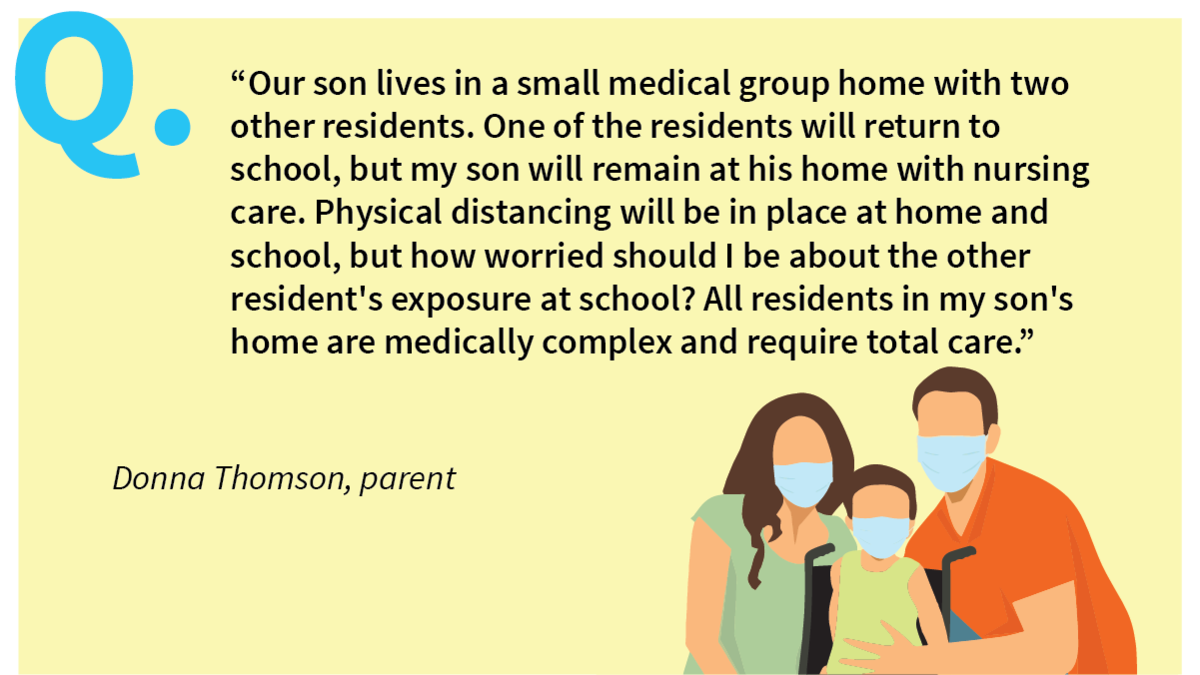
"Our son lives in a small medical group home with two other residents. One of the residents will return to school, but my son will remain at his home with nursing care. Physical distancing will be in place at home and school, but how worried should I be about the other resident's exposure at school? All residents in my son's home are medically complex and require total care."
- Donna Thomson, parent
Response from Dr. Eyal Cohen (Physician at The Hospital for Sick Children and Professor at University of Toronto):
The risk of transmission in the school and/or residence depends on two important factors: a) how much COVID there is in the community at the time, and b) what measures are put in place to mitigate the risk in each setting. While it is impossible to eliminate all transmission risk, if both locations have protocols in place to lower risk, including physical distancing, but also screening, hand hygiene, small cohorts, masking and other more specific infection control protocols for children with enhanced care needs, the overall risk should be relatively low.

"Summer camps are cancelled in my region this year. What are we going to do for fun and socialization?"
Response from Dr. Keiko Shikako-Thomas (Canada Research Chair in Childhood Disability, Participation and Knowledge Translation):
I know this has been one of the many challenges during these months! Statistics Canada has surveyed families and found that this is indeed a problem for most families! Screen time was the most popular daily activity during COVID-19 for 89% of the families! (for Statistics Canada infographic check here)
There are several ways to stay active and ideas to maintain kids busy! At @JooayApp we have now added over 400 activities that are being offered either online or through hybrid live/online formats across Canada! All the activities are also listed at our #CommunityConnectingToPlay https://www.facebook.com/groups/JooayCommunity
To give you some examples of summer camps that are being offered online:
- Online Summer Camp - Stomping Ground
- Online Summer Camp Musical Theater and Acting Workshops
- Online Camp Awakening at Home - Camp Awakening
- Online Art Camps - YMCA at Home
- Online Summer Camp Animation and Film Workshop
@ParticipACTION has put together many different resources and activities on their website for individuals or families to do to stay active. Their blog also has some great stuff. And on their Facebook page has tons of videos for quick and fun fitness breaks (all added during COVID-19).

"Is it reasonable for a parent to advocate for her child to repeat grade 3 post COVID? My daughter is 8, has Down syndrome, and late birthday (Nov 29). Her neurotypical brother struggled in grade 1-2, also a fall birthday but with a bit of support propelled to become one of the best students in terms of academics. His experience led me to research the "redshirting" phenomenon for neurotypical populations with late birthdays as well as social and academic benefits from keeping a child in the same grade. Repeating grade 3 appears to make sense for a number of reasons: social, maturity and academic (she is more comfortable with grade 2 school work). Making this move now post COVID also makes sense considering how much school was missed and social connections were interrupted. Anyways, Grade 3 is also the last year in the low elementary grouping but I would like to hear experts' opinions. I am aware that school boards practice the culture of promotion now, even though I do hear some individual families making a successful case for repeating the grade, closing the gap and reducing some stress. A good research study may be to follow up with those families to see how their children fare afterwards?"
CanChild consulted with educational experts who advised:
It is never unreasonable to ask. Certainly COVID adds a new dimension. There are, however, several aspects to consider before making that decision. Firstly, parents know their child best and should make that decision in connection with school staff as school and home connections are key to decision-making. Having a robust conversation with school staff can provide insight on how to move forward. Secondly, while each decision is always individual, repeating a grade is generally problematic because it can disrupt a child’s friendships and social relationships. Lastly, curriculum outcomes can be adjusted, and invariably will be over time, so it is important for parents to consider the social and developmental aspects. Hope these tips help going forward.
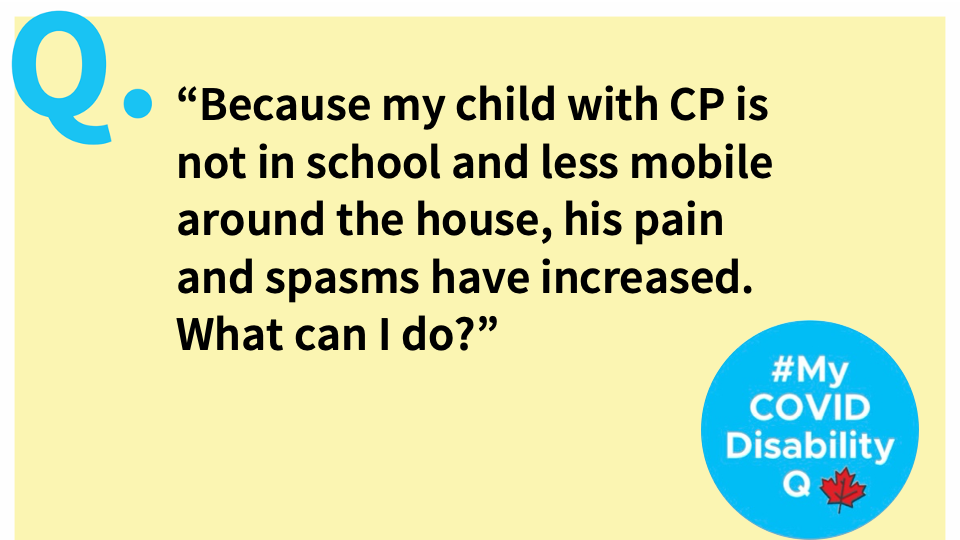
"Because my child with CP is not in school and less mobile around the house, his pain and spasms have increased. What can I do?"
Response from Dr. Jan Willem Gorter (Professor in the Department of Pediatrics at McMaster University and Director of CanChild):
Thank you for another #MyCOVIDDisabilityQ! Many children with disabilities, including those with cerebral palsy, have challenges to be physically active due to COVID-19. They miss their daily routine, such as school. At home many children are sitting too much. While we all should move more, sit less and make sure we get enough sleep per day for our health and well-being, this is even more important for children with CP. Less movement can make the muscles stiff and sore. Therefore it is important to think in a creative way what can be done to stay active in and around the house. For children who are able to walk it may be going up and down the stairs to get some extra exercise and stretch the muscles. For other children with CP it may other activities to reduce sitting time, like standing in a stander or walking in a walker, being on a trampoline, or if possible swimming, to name a few. Ask your therapist or specialist if you would like some advice on specific exercises, equipment or, if needed medication. If your child is on medication already it may be that he or she needs an adjustment of the dose. Most healthcare services are now beginning to resume appointments paused due to covid-19, either in clinic or virtual. Do not hesitate to contact your healthcare team if you have urgent health needs.

"How can I teach my child with autism physical distancing? Is it ever safe to bring her outside during COVID?"
Response from Dr. Briano Di Rezze (Assistant Professor in the School of Rehabilitation Science and CanChild Scientist at McMaster University):
Hi there. Thanks for this #MyCOVIDDisabilityQ. I definitely think that children should be getting outside, especially in these summer months and we know that COVID transmission is low outdoors. With regards to teaching children about physical distancing, each child will differ in what ways that are most effective for them to learn. This will also depend on their developmental age. However, children with autism usually respond well to instructions when they are framed as “rules”. The concept of physical distancing can be tough for any child to understand but working together with the child to establish visual cues for physical distancing could be a good way to talk about the “rules”. With some of the young children in my family, I showed them what one metre looked like with my legs wide apart and had them come up with things that were about equal in length. The rules around this can be discussed as important during this unique time and will not always be the case forever. I also think that it is important to reassure children that these rules are meant to keep everyone healthy so that they can enjoy the summer months.
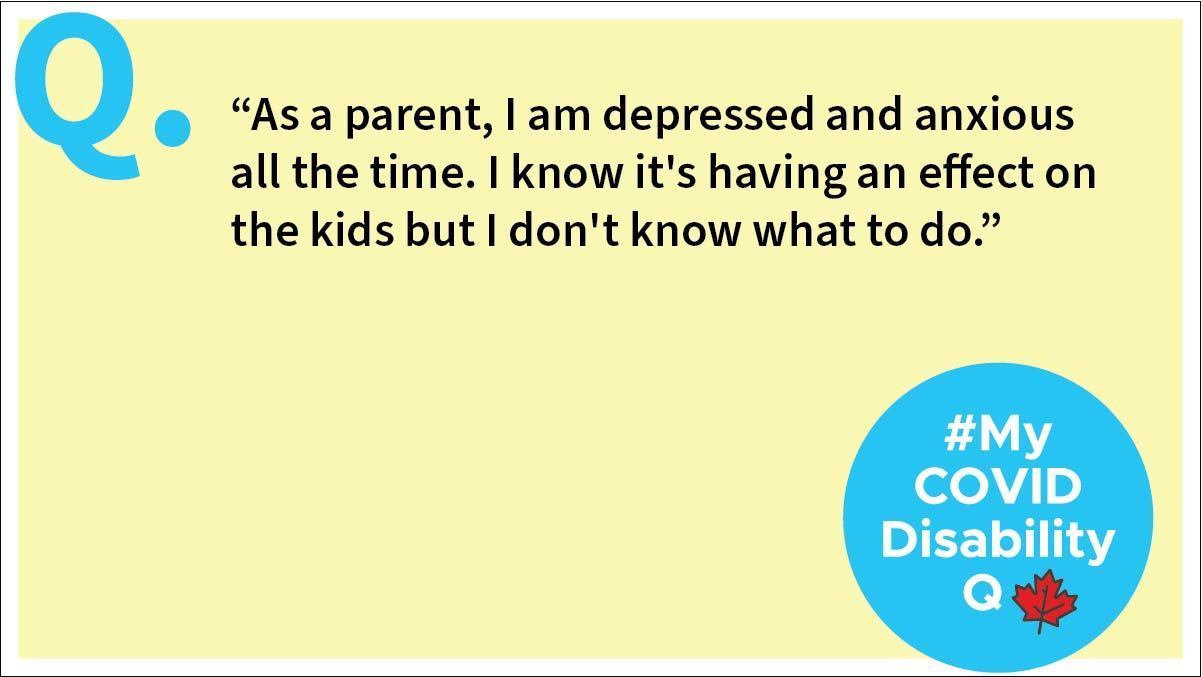
"As a parent, I am depressed and anxious all the tme. I know it's having an effect on the kids but I don't know what to do."
Response from Dr. Grace Iarocci (Psychology Professor and Director of the Autism and Developmental Disorders Laboratory at Simon Fraser University):
Thanks for your #MyCOVIDDisabilityQ! I am sorry to hear that you are experiencing depression during such a stressful time. If you are feeling overwhelming anxiety or depression that is interfering with your ability to care for your children or you feel that your distress is affecting your children's emotional well-being, I would recommend seeking professional advice from a psychologist, counsellor or family doctor.
Here is where you can find a psychologist and other resources to help:
- Finding the Psychologist For You - Canadian Psychological Association
- Find a Psychologist - Canadian Register of Health Service Psychologists (CRHSP)
- “Psychology Works” Fact Sheet: Psychological Impacts of the Coronavirus (COVID-19)
- “Psychology Works” Fact Sheet: Working from Home During COVID, With and Without Children
- “Psychology Works” Fact Sheet: Grief, Bereavement and COVID-19
- Virtual Mental Health Supports During COVID-19
- How to access free mental health and emotional support during the COVID-19 crisis
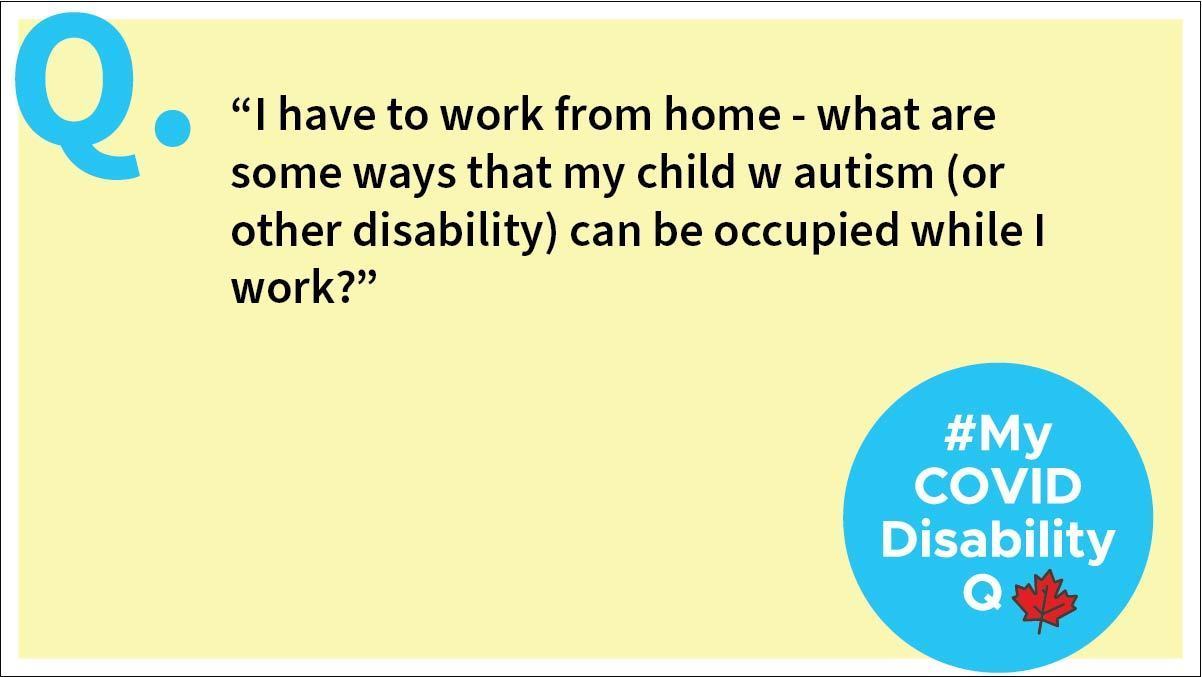
"I have to work from home - what are some ways that my child with autism (or other disability) can be occupied while I work?"
Video response from Dr. Lonnie Zwaigenbaum (Professor and Director of Autism Research in the Department of Pediatrics at the University of Alberta):
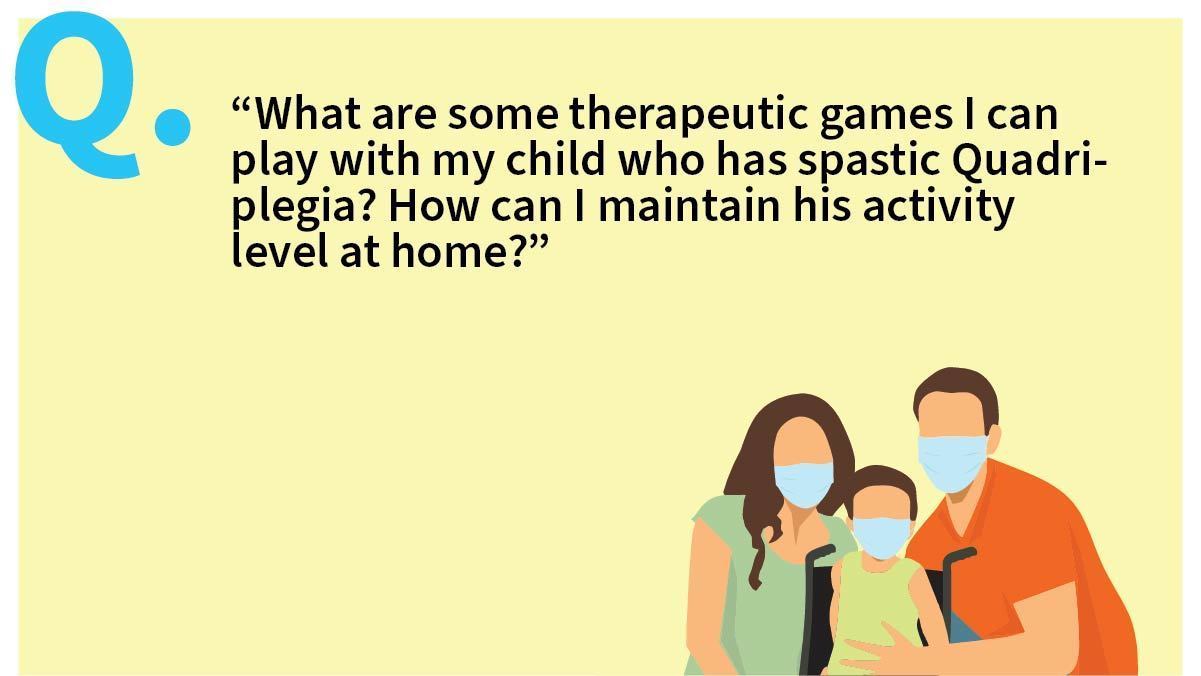
"What are some therapeutic games I can play with my child who has spastic Quadriplegia? How can I maintain his activity level at home?"
Response from Alison Pritchard Orr (Associate Professor in the Faculty of Health Sciences, Kinesiology at University of the Fraser Valley):
It’s always best to consult with a medical practitioner prior to any physical activity involvement for your child. Also, the number one priority is what does your child enjoy doing? What physical activities do you enjoy as a family and how can you involve your child? A great place to start is with expert advice. I would suggest you download the CSEP Activity Toolkit for 24-hour movement guidelines for parents of children or youth with disabilities. This toolkit is based on typically developing children as more research needs to be done on the specific needs of children with disabilities, but it includes some good ideas for light physical activities that only require a small amount of effort and moderate physical activities that can be either aerobic, muscle strengthening or bone strengthening activities.
For children with spastic quadriplegia, it is recommended that attention be paid to activities that will help with reducing the impact of some retained reflexes like the asymmetrical tonic neck reflex (ATNR) the symmetrical tonic neck reflex (STNR), tonic labyrinthine reflex (TLR- prone and supine) and the crossed extension reflex (Active Living Alliance). Reflex integration is an option for children with retained primitive reflexes (Bowden, 2019). It is best to contact a trained physiotherapist for suggestions here.
For less strenuous movement ideas, consider flexibility exercises, passive resistance stretching or passive range-of-motion activities (parents assist). For children with muscle spasticity, focus should be on strengthening extensor muscles with the goal to develop a balance between flexor and extensor muscles. “Floor climbing” is a fun option here utilizing contralateral body movement. A scooter board can be used for variety and fun.
Yoga is an enjoyable way to incorporate stretching with some poses that will help your child increase or decrease their muscle tone, improve breathing and enhance balance and bilateral coordination (Active Living Alliance for Canadians with a Disability (www.ala.ca). Dance is also a good option. This can be done in any fashion, at any level- just let the music move you!
For strengthening activities; use any type of tubing for resistance. You can buy resistance bands at most department stores or buy online, or you can make your own by using bicycle inner tubes or surgical tubing. You can also play catch or paddle ball games together. Attach Velcro to lightweight paddles that can be purchased at a dollar store so your child can grasp the handle with support.
I would recommend these sites for additional information: Active Living Alliance for Canadians with a Disability, Canadian Disability Participation Project, Sport for Life Society, ParticipACTION – Visit “150 Play List” and “Build Your Best Day!” webpages. The key is to make sure any activity you participate in with your child is first and foremost safe, fun and preferably one that will involve the family in ways that benefit everyone.
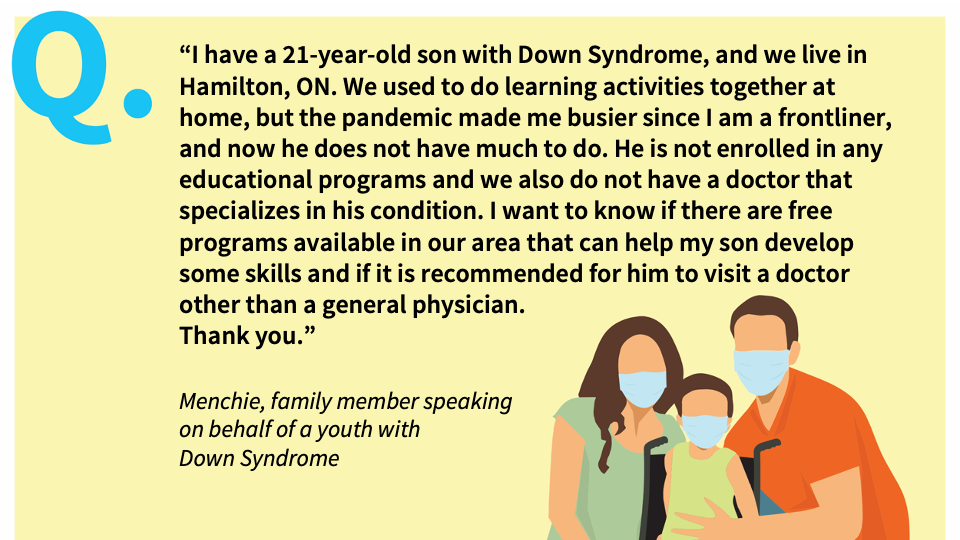
"I have a 21 year old son with Down Syndrome and we live in Hamilton, ON. We used to do learning activities together at home but the pandemic made me busier since I am a frontliner, and now he does not have much to do. He is not enrolled in any educational programs and we also do not have a doctor that specializes in his condition. I want to know if there are free programs available in our area that can help my son develop some skills and if it is recommended for him to visit a doctor other than a general physician. Thank you."
- Menchie, family member speaking on behalf of a youth with Down Syndrome
Response from Dr. Olaf Kraus de Camargo (Associate Professor in the Department of Pediatrics at McMaster University):
Thank you, Menchie for this important question. I must admit, that I struggled as well to find opportunities for young adults such as your son. The activities on the Hamilton Down Syndrome Association for young adults unfortunately have an age limit of 21 (https://www.dsah.ca/). I spoke with colleagues at our Ron Joyce Children’s Health Centre and they are aware of the lack of opportunities and there is a group working on setting up a program for young adults over 21, but this will still take a while. I am also aware of T.E.A.D Equestrian Association for the Disabled (https://tead.on.ca). They are slowly reopening and might have an opportunity for volunteering, if working with animals interests your son.
With regards to seeing a doctor, we recommend to visit a general practitioner who are usually familiar with the general guidelines for health monitoring of people with Down syndrome and can then decide if a specialist appointment is indicated. Here is a link to the website of the American Academy of Family Physicians with more information: https://familydoctor.org/down-syndrome-in-adults-staying-healthy/
Wishing you and your son all the best!
Wearing of Masks for Kids during COVID-19
Dr. Olaf Kraus de Camargo (Associate Professor in the Department of Pediatrics at McMaster University) talks about the importance of wearing mask for children during COVID-19.

"The backyard is the only safe outdoor space for my son with autism. The neighbour complained and shouted at him to be quiet. How can I educate my neighbour about autism?"
Video response from Dr. Lonnie Zwaigenbaum (Professor and Director of Autism Research in the Department of Pediatrics at the University of Alberta):
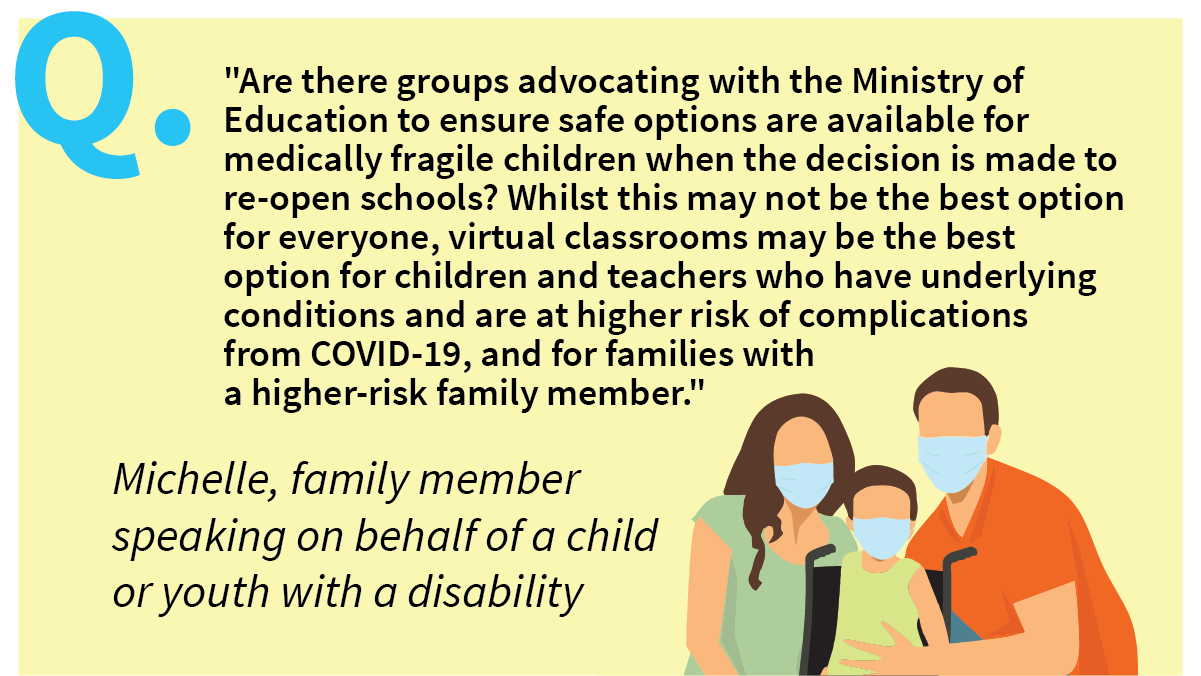
"Are there groups advocating with the Ministry of Education to ensure safe options are available for medically fragile children when the decision is made to re-open schools? Whilst this may not be the best option for everyone, virtual classrooms may be the best option for children and teachers who have underlying conditions and are at higher risk of complications from COVID-19, and for families with a higher-risk family member."
- Michelle, family member speaking on behalf of a child or youth with a disability
Response from Dr. Jennifer Zwicker (Director of Health Policy at the School of Public Policy, University of Calgary):
Important #MyCOVIDDisabilityQ Michelle! The UN Convention on the Rights of Persons with Disabilities recognises the right to inclusive education for all persons with disabilities: #AccessAbility education planning for schools is critical. UNICEF provides some practical guidance in interpreting Article 24 and the right to inclusive education. They also provide some guidance on what governments must do ensure inclusive education. Provincial ministries of education are responsible for delivering inclusive education, which includes a plan of action around inclusive education as schools reopen. ARCH Disability Law provides a guide to these rights generally in Ontario as an example.
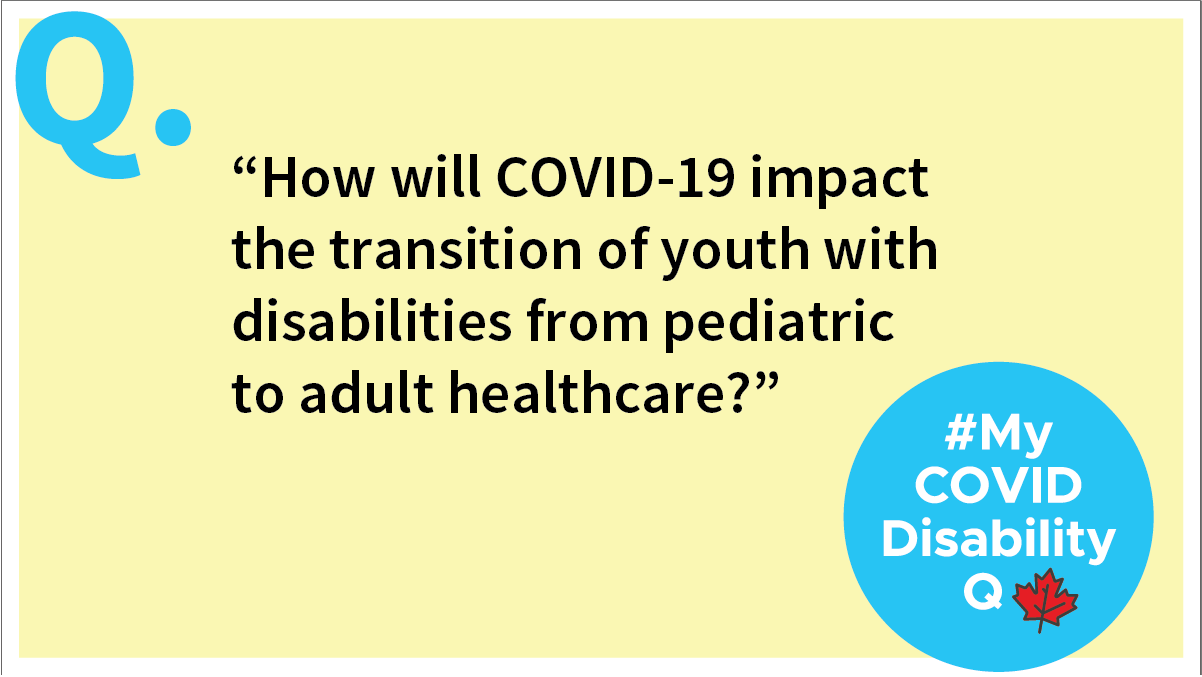
"How will COVID-19 impact the transition of youth with disabilities from pediatric to adult healthcare?"
Response from Dr. Jan Willem Gorter (Professor in the Department of Pediatrics at McMaster University and Director of CanChild):
Thank you for another #MyCOVIDDisabilityQ! We know that transition to adult services can be hard for young people and their families. With COVID-19 it can be even harder! A transfer to adult-oriented services can happen at a system-defined age. For example, in Ontario, this is age 18 for the Children's Hospitals. Be aware that turning 18 comes with change in services, so it is important to plan early for a good adult life. Transition is like a journey, requiring good planning ahead which takes time. Having early conversations do help. Transition programs & supports may not be available to you during COVID-19. Make sure you are prepared and check-in with your doctor and other service providers. Ideally, make sure you are connected to a family doctor or specialist in adult healthcare before you leave the pediatric services. In my view, it is important to advocate for flexibility for age-related transfer during COVID-19 (e.g., an extra year to plan for transition). We are interested in hearing your experiences to help advocate for the needs young people and families have during their transition to adult healthcare services. Please send an email gorter@mcmaster.ca

"How can children with disabilities continue to develop their social skills with limited socializing and playtime with friends?"
Response from Dr. David Nicolas (Professor in the Faculty of Social Work at the University of Calgary):
Thanks for this excellent #MyCOVIDDisabilityQ. It is essential to recognize how severe the disruptions have been for so many children. Try scheduling regular times for your child to enjoy a video call with a friend or relative. After the virtual chat, check with your child about what they enjoyed, what was difficult, and what could be different in future interactions. Also, there may be online social groups and programs in your community that might help in fostering social skills and connections. Importantly, be cautious and ensure that your child is safe in their internet use. Be aware of what your child is doing online, and with whom and how they’re engaging. Talking about ways to engage online safely is very important. Some resources can be found, with many of them online. As an example, the Geneva Centre for Autism: PEERS Online Social Skills Group/Program lists a free program funded by the Ontario Trillium Foundation, which meets weekly online. The group provides adolescents with the opportunity to learn skills to nurture meaningful friendships while staying connected and engaged with their peers. For questions or registration, e-mail groupservices@autism.net or visit https://bit.ly/2zTFrkJ.
At home, there could be opportunities to work on social skills with family members. The following types of examples of activity may help build social skills. As a family, engage in activities that include members of the family (e.g., board games, puzzles) working collaboratively together to achieve a shared goal. Team building games that would usually involve greater numbers can be modified to work with family members. The We Are Teachers website has several team-building games that you could try with family members. If any are particularly enjoyable, you may want to remember them, so you can try them with others when social distancing is no longer required: https://www.weareteachers.com/team-building-games-and-activities/. Even family chores or activities can provide opportunities to focus on social skills. Take baking cookies, for example. You could assign different roles (e.g., recipe reader, measurement master, ingredient retriever). These roles can build a greater understanding of different social roles, like the ability to lead a group and follow others’ directions.

"Why would a child with neurological disability be considered higher risk? I have read papers from a number of reputable orgs that state this is the case, however, neurological disabilities have a very broad spectrum (autism through extreme medical fragility). Now that "they've" lumped them together and issued this blanket caution, I would like more specific physiological reasons for the concern. I'm anxious after reading these papers/articles... am I worrying unnecessarily?"
- Kris, family member speaking on behalf of a daughter with a brain injury.
Response from Dr. Keiko Shikako-Thomas (Canada Research Chair in Childhood Disability, Participation and Knowledge Translation):
Hi Kris! CHILD-BRIGHT Network has supported a quick look at the current research to answer your exact question. What we found, unfortunately, is that children with brain-based disabilities are not represented in the research on COVID to date. What it means is that we don't really know if we haven't asked children with COVID if they also have a disability, or if this information has not been reported in current public health initiatives. We can't tell, from the current research, if this group is at higher risk. General guidelines alert for possible higher risks due to frequent co-morbidities that children with disabilities may have, which may put them at risk of using the healthcare system more often, or needing hospital visits for other reasons associated to their disability. We will look at the research evidence again in a few months and see if there is more info. In the meantime we're also pledging for better data collection on this population. You can see the full review here https://www.child-bright.ca/new-blog/2020/5/15/covid-rapid-review and stay tuned to a survey coming out soon!
Response from Dr. Olaf Kraus de Camargo (Associate Professor in the Department of Pediatrics at McMaster University):
Hi Kris, this is a topic discussed quite intensely. Two aspects need to be considered for children with neurodevelopmental issues: 1 - their breathing (ex: do they struggle usually to cough?, do they gag easily? Can they move themselves to facilitate coughing?) 2- some children with neurodevelopmental issues also present with some immunedeficiencies, which would also put them at a higher risk.

"Why did people on OSD only receive 100? Many of us have had to send people out to get our stuff now. And have to pay some people! Many had to go may times since stock is not available. We need to get ahead a bit on stuff and do not have the money to do so. We are also the most vulnerable amongst society living at the poverty level or below. So frustrating! No one ever seems to go bat for us in any political party." - Tammy, family memeber speaking on behalf of a child or youth with a disability.
Response from Nancy Lockwood (Program Manager at Citizen Advocacy Ottawa):
We have seen this question raised by various groups in Ontario with a disability focus. We agree that now, more than ever, we need to ensure that people with visible and invisible disabilities are receiving the supports they need. We are witnessing this firsthand among the people we support at our agency, Citizen Advocacy Ottawa. Like so many other agencies, we are developing new, creative ways to connect with the people we support during social isolation. These methods have included virtual support groups / social gatherings, caregiver groups, webinars and direct outreach via teleconference, phone and email. We are even holding virtual dances with a DJ to reduce social isolation!
Our governments are supporting people with disabilities in a variety of ways, in addition to direct funding. Many initiatives launched during COVID-19 are run by agencies that receive government funding (federal, provincial and municipal), demonstrating another way of impacting the lives of people with disabilities. For example, our agency's Fetal Alcohol Resource Program supports people with Fetal Alcohol Spectrum Disorder through a combination of funding from Kids Brain Health Network, CHEO Hospital via funds provided by Ontario's Ministry of Children, Community and Social Service, and the Children's Aid Society of Ottawa. This program supports hundreds of clients and has trained thousands of front line workers thanks to these funding partners.
Concerning the Ontario Disability Supports Program (ODSP), the Ontario government initially announced a one-time benefit of $100 per individual or $200 per family for those receiving monthly ODSP payments. This plan has been revised, likely due to public feedback, to a monthly addition to ODSP benefit until July 2020. Please see: https://www.mcss.gov.on.ca/en/mcss/programs/social/odsp/odsp-covid-fact-sheets.aspx
Also, some individuals receiving ODSP will qualify for the Canada Emergency Relief Benefit (CERB). CERB funds will be treated as employment income. There is more information at the link provided above. People with developmental disabilities who qualify for Passport funding in Ontario may be eligible to claim additional expenses during Covid-19 https://www.mcss.gov.on.ca/en/mcss/programs/developmental/servicesupport/passport.aspx.
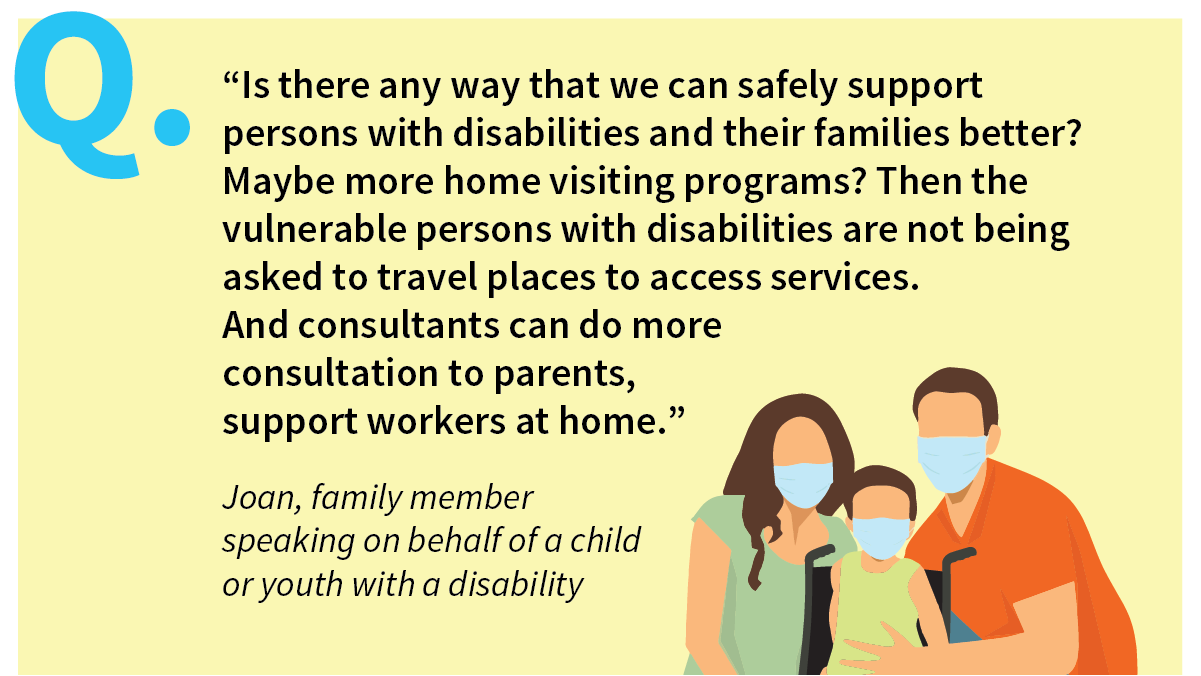
"Is there any way that we can safely support persons with disabilities and their families better? Maybe more home visiting programs? Then the vulnerable persons with disabilities are not being asked to travel places to access services. And consultants can do more consultation to parents, support workers at home."
- Joan, family member speaking on behalf of a child or youth with a disability
Response from Dr. Michelle Phoenix (Assistant Professor in the School of Rehabilitation Science at McMaster University):
Some ideas for accessible and safe supports for people with disabilities:
- Use phone or video consults when possible. Availability may vary by service and agency, call your providers or check social feeds + website to know what you can access remotely.
- If in home supports are needed (e.g., nursing, PSW) ask about the number of clients your provider is seeing (1 would be ideal). Check and advocate for proper use of PPE. If you are responsible for securing PPE and access is difficult be vocal, this needs to be addressed.
- If hospital care is needed check "visitor" polices. Policies may differ by province and hospital. Caregivers are partners in care that can increase care quality, communication and safety. A campaign exists to increase caregiver access here: https://t.co/Es1fVX9MHL?amp=1
I hope families know they are not alone. Researchers, families, policy makers, service organizations need to collaborate to improve access to safe care. Thanks for raising the question. My detailed thoughts are here: https://www.cbc.ca/news/canada/hamilton/children-disabilities-coronavirus-1.5571099
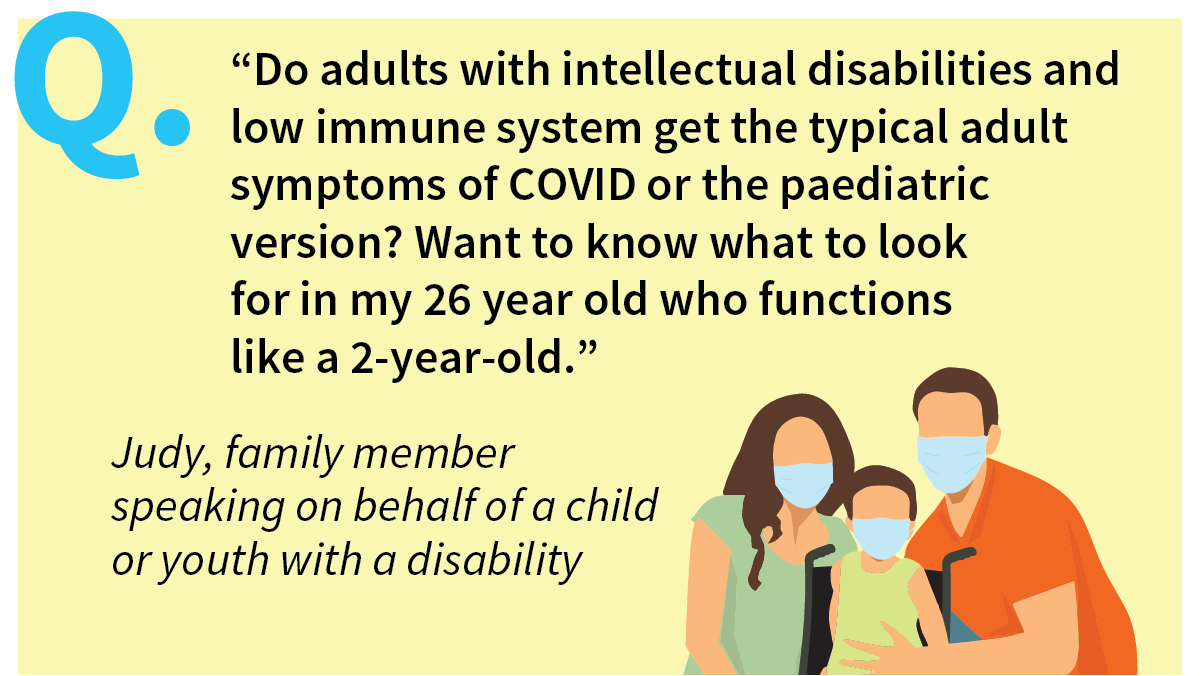
"Do adults with intellectual disabilities and low immune system get the typical adult symptoms of COVID or the pandemic version? Want to know what to look for in my 26 year old who functions like a 2-year-old."
- Judy, family member speaking on behalf of a child or youth with a disability
Response from Dr. Francois Bolduc (Associate Professor in the Department of Pediatrics at University of Alberta):
Everyone’s immunological response to COVID-19 may be different. The advice is similar to what is recommended to the general population for most individuals to prevent risks.
Also, here are a few useful links I found that might be useful about children, young adults and COVID19:
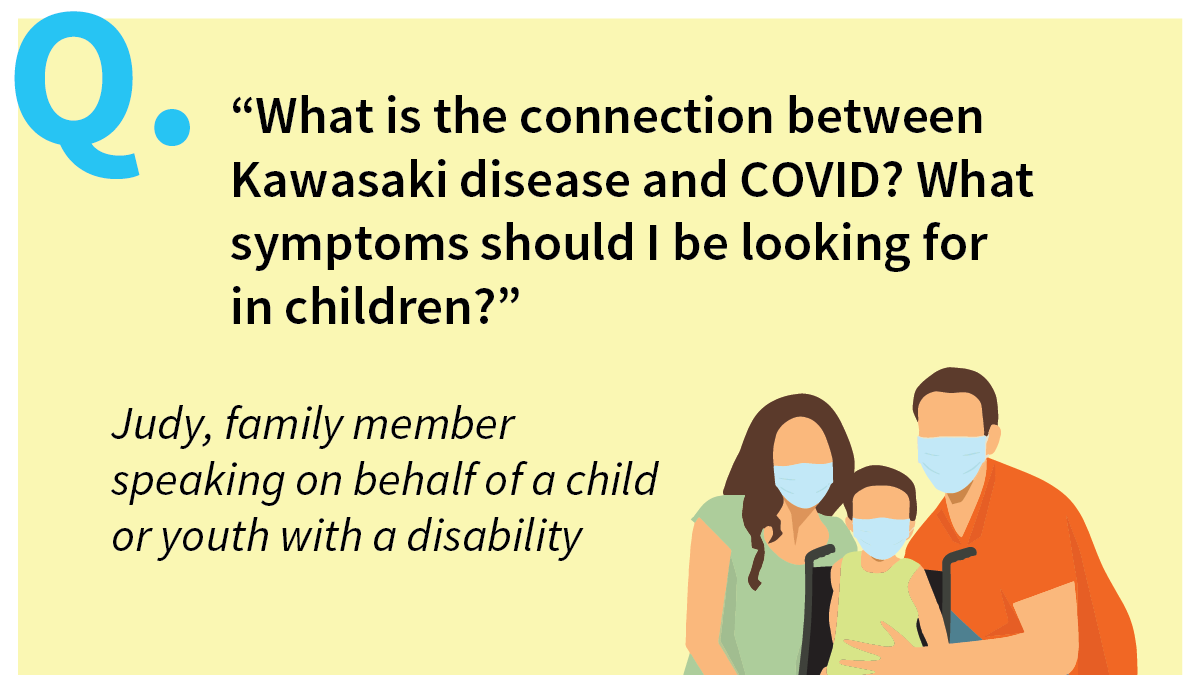
"What is the connection between Kawasaki disease and COVID? What symptoms should I be looking for in children?"
- Judy, family member speaking on behalf of a child or youth with a disability
Response from Dr. Francois Bolduc (Associate Professor in the Department of Pediatrics at University of Alberta):
What is the connection between Kawasaki disease and COVD-19?
This connection is an emerging issue. Individuals who tested positive for COVID-19 were noted to have a major inflammatory response similar to Kawasaki syndrome. We now refer to it as Multisystem inflammatory syndrome in children (MIS-C). This connection was reported in a 6 months-old infant and has now been seen in more individuals. A recent report from Italy in the journal Lancet also reveals an increase in the number of cases of Kawasaki syndrome since the COVID-19 pandemic.
What symptoms should we be looking for in children?
According to the Centre for Disease Control (CDC), Kawasaki syndrome is characterized by a combination of symptoms including fever, rash, enlarged lymph nodes, as well as other symptoms and can lead to acquired heart disease.
The American Heart Association (2017) also developed a set of criteria to recognize Kawasaki syndrome. In the more typical form, the symptoms include fever associated with 4 or more of the following:
- redness of the eyes (conjunctivitis)
- changes of the lips or mouth
- neck lymph node enlargement
- skin rash, redness of the palms and soles
- firm swelling/thickening of the hands and feet
In addition to the symptoms listed above, it is crucial to look for abdominal and neck pain as well as vomiting and diarrhea as the gastrointestinal system can be involved.
There is also an incomplete form of the syndrome where patients can present partial symptoms. The criteria for this form include fever for 5 days or more, plus up to three of the criteria mentioned in the classic form.
For more information on the link between Kawasaki Disease and COVID-19, please see the CDC Summary on how to care for children with Multisystem inflammatory syndrome (MIS-C) during COVID-19 (scroll to the bottom of page).
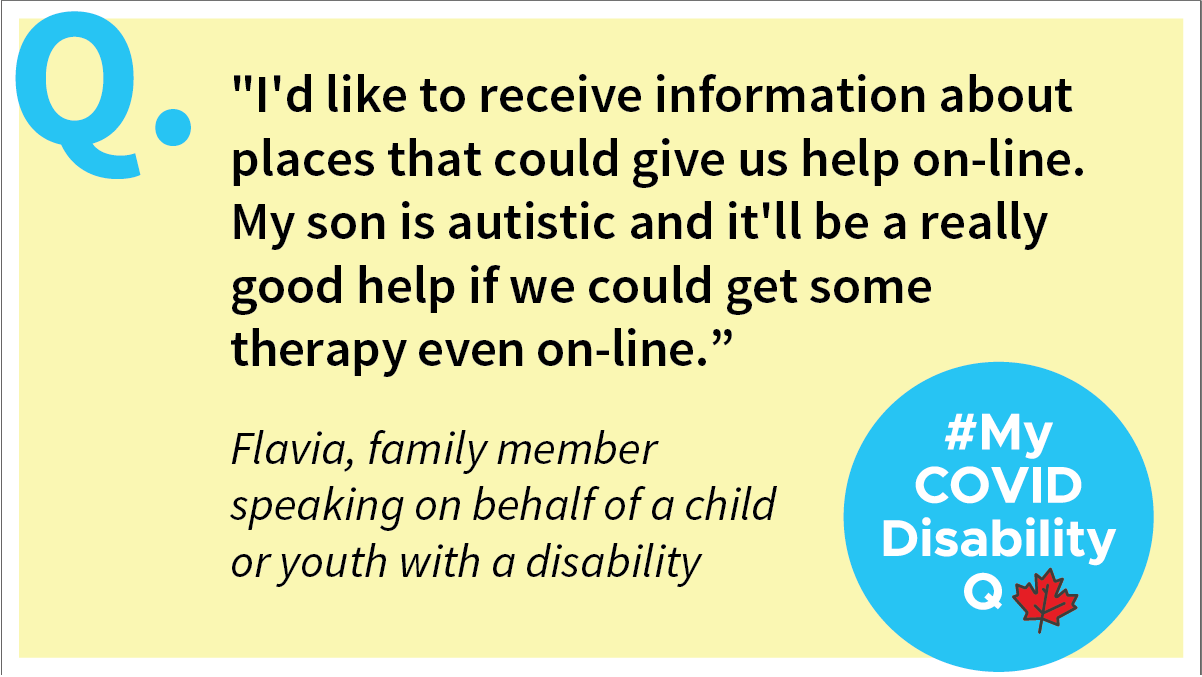
“I'd like to receive information about places that could give us help on-line. My son is autistic and it'll be a really good help if we could get some therapy even on-line”
– Flavia, parent of a child with a disability
Response from Dr. Olaf Kraus de Camargo (Associate Professor in the Department of Pediatrics at McMaster University):
Thank you for this question, Flavia. The answer depends where you live in Canada. In Ontario, your son needs to be registered to the #OAP (https://tinyurl.com/mycovidOAP). If you already have a service provider, contact this service provider. Many are offering virtual care and support that has been quite helpful to some of my patients. On the website https://tinyurl.com/mycovidASD you can also find free workshops that address common issues in Autism.
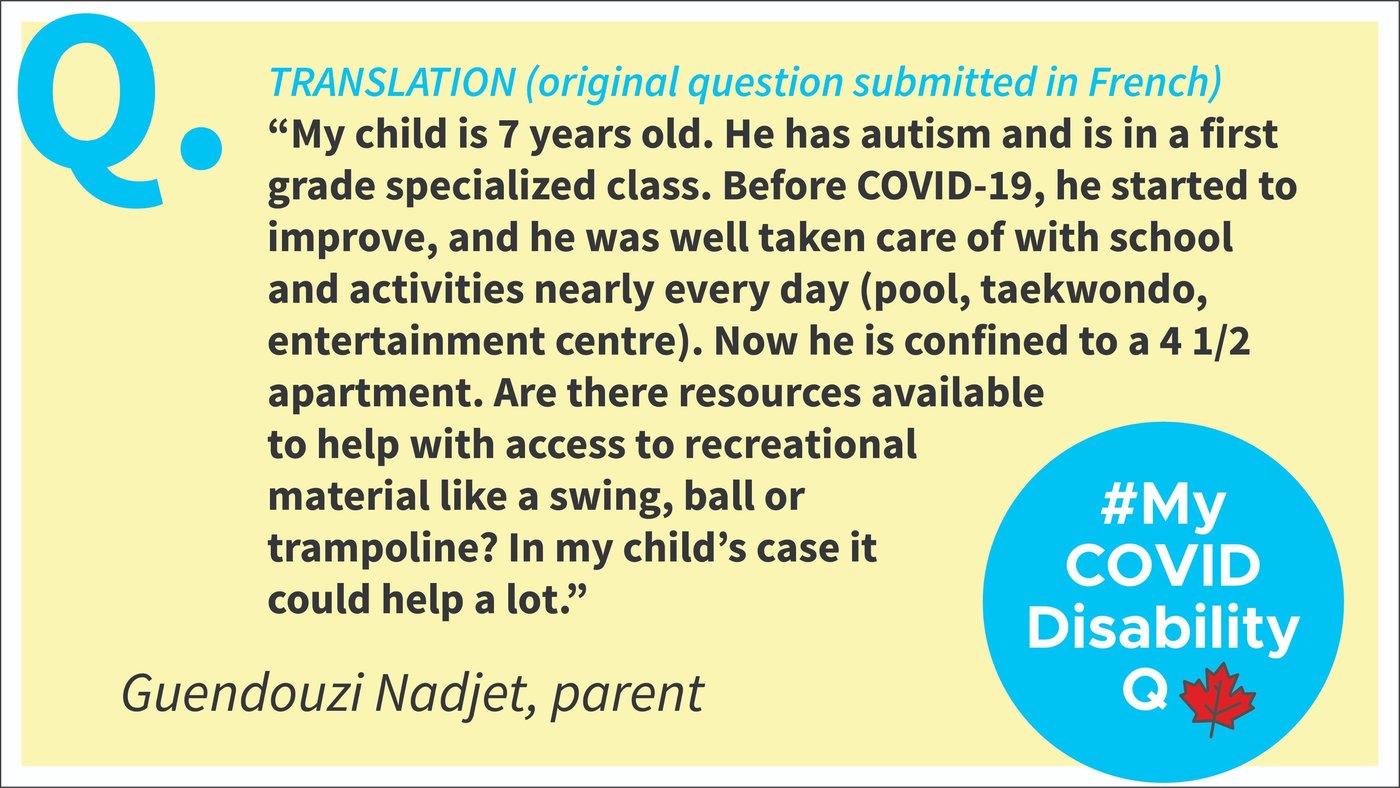
"My child is 7 years old. He has autism and is in a first grade specialized class. Before COVID-19, he started to improve, and he was well taken care of with school and activities nearly every day (pool, taekwondo, entertainment centre). Now he is confined to a 4 1/2 apartment. Are there resources available to help with access to recreational material like a swing, ball or trampoline? In my child's case it could help a lot."
- Guendouzi Nadjet, parent of a child or youth with a disability
Translation of response from Dr. Keiko Shikako-Thomas (Canada Research Chair in Childhood Disability, Participation and Knowledge Translation):
Having a routine is especially important. Dr. Keiko Shikako-Thomas suggests structuring your child’s time around their preferences. You know your child best! Do they prefer movement, quiet time, or perhaps music? Build a routine that has work, leisure, and relaxation components. Don’t forget to build in structured time for your child to communicate how they are feeling to you. Having a space where they are listened to and their needs are answered can be reassuring. If your child likes active play, use what you have at home before going out to buy expensive equipment! You can find ways to play with stairs, or by running around the building. Even jumping on the bed can be a DIY trampoline! Finally, take a look at the resources for inclusive leisure and mental health that Dr. Shikako-Thomas identified: https://twitter.com/KShikakothomas/status/1263142335292026885?s=20
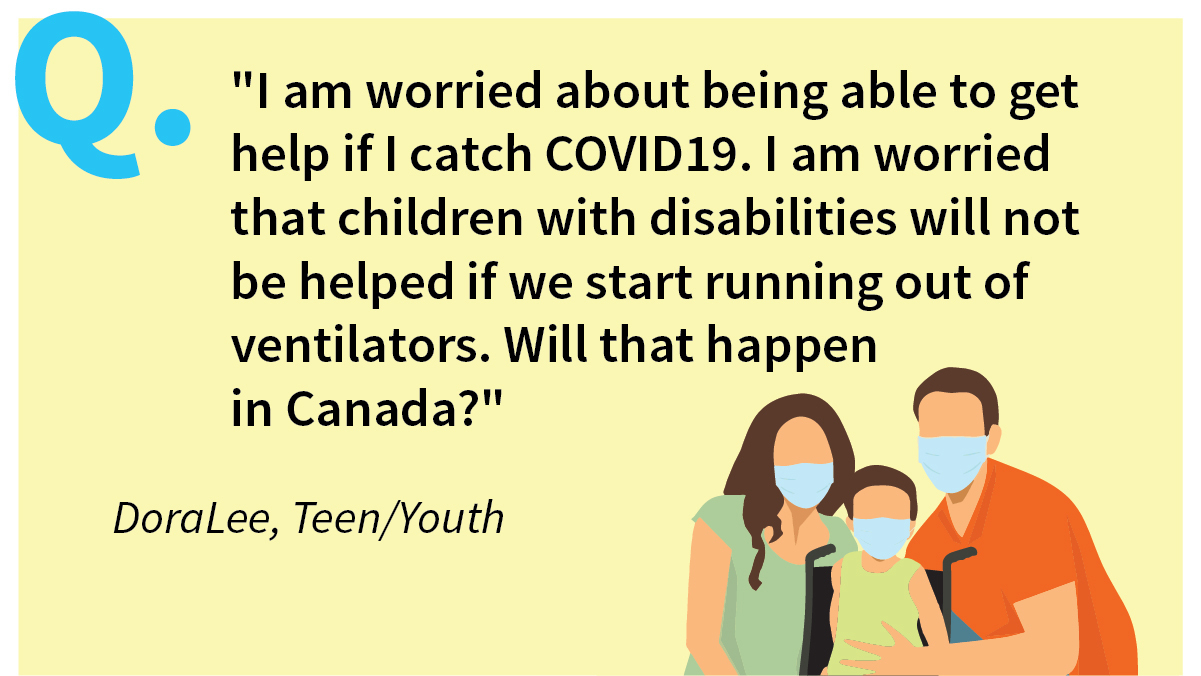
"I am worried about being able to help if I catch COVID19. I am worried that children with disabilities will not be helped if we start running out of ventilators. Will that happen in Canada?"
- Dora Lee, Teen/Youth
Response from Dr. Jennifer Zwicker (Director of Health Policy at the School of Public Policy, University of Calgary):
Thanks for this important #MyCOVIDDisabilityQ Dora Lee! In Canada youth with disability have a right to equal access to health care services. Ministers @CQualtro (Carla Qualtrough) and @PattyHajdu (Patty Hajdu) provided provincial and territorial ministers of health with this guidance: https://www.include-me.ca/covid-19/resource/letter-provincial-and-territorial-ministers-minister-qualtrough-and-minister-hajdu
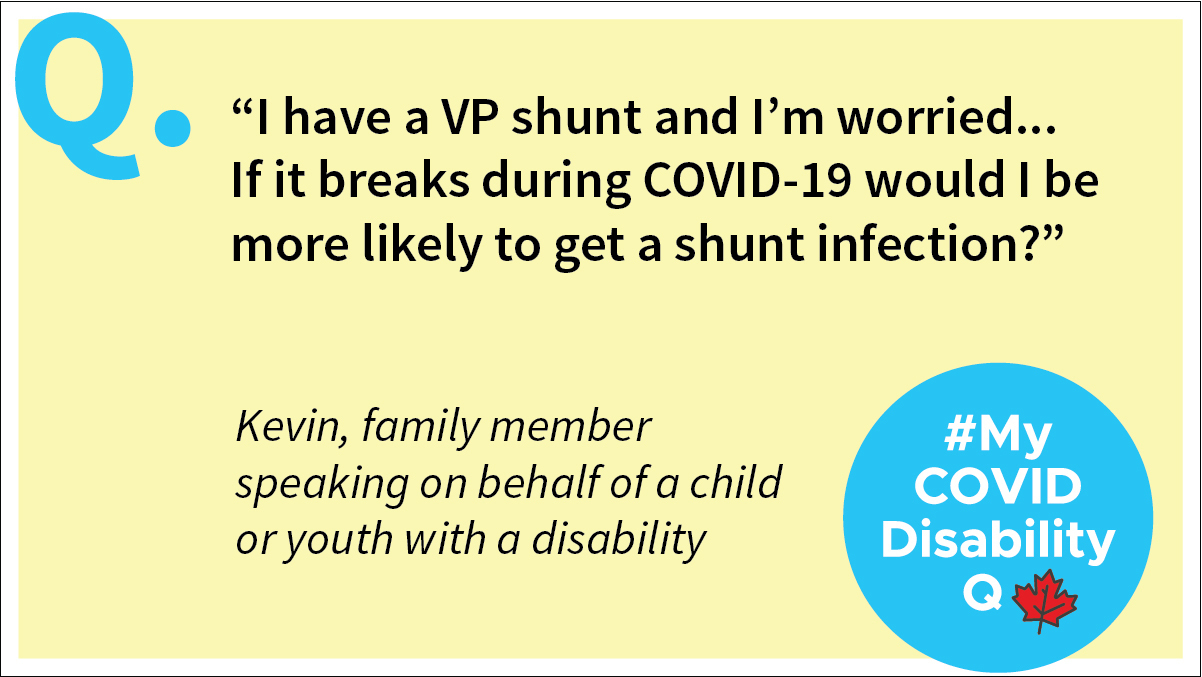
"I have a VP shunt and I'm worried... If it breaks during COVID-19 would I be more likely to get a shunt infection?"
- Kevin, family member of a child or youth with a disability
Response from Dr. Adam Kirton (Pediatric neurologist at the Alberta Children's Hospital in Calgary):
"Thanks for your question Kevin. There is no increased risk. COVID is a viral infection that does not appear to infect the nervous system or devices like shunts directly. In contrast, shunt infections are caused by bacteria that usually come from inside the body.
Even if you had to go to hospital, infection risks there are lower than ever because people are in isolation and being extra cautious about infection prevention."

